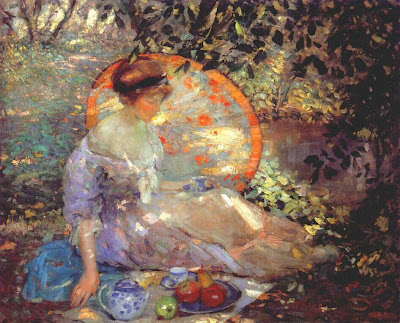Where I live, the main art museum exhibits run the gamut from ghastly (a recent showing of feminist art from Paris) to mediocre to good. Those are my opinions, anyway.
Happily for me, the Seattle Art Museum is one of four U.S. sites for an exhibit of paintings from London's Kenwood House. Kenwood is undergoing restoration, so the artworks assembled by Edward Cecil Guinness, first Earl of Iveagh (1847-1927), he of the Dublin brewery family, had to be vacated to storage or the road. Guinness was extremely rich and astute enough to beat even more wealthy American art collectors to the punch during the late 1800s rush to acquire masterpieces.
The exhibit's title features the names of Rembrandt, Van Dyck and Gainsborough to attract visitors. But for me, the most interesting works were by British portrait painters active roughly 1750-1830. These included Joshua Reynolds, Thomas Lawrence, George Romney and Henry Raeburn, among others. Also on view was a very nice non-portrait chiaroscuro by Joseph Wright of Derby, a dramatic hawking scene by Edwin Landseer and the excellent Pieter van den Broeke by Frans Hals.
Whether by accident or design, on adjoining walls were hung portraits of the same subject by two different artists. That subject was Sophia Heywood, the Mrs. John Musters (1758-1819), a well-known at the time, socially prominent beauty of the late 1700s. The dirt on Mrs. Musters can be found here, and another piece that strikes me as being less well researched is here.
Here are the paintings I saw:
By Joshua Reynolds - "Mrs. Musters as 'Hebe'" - 1782
By George Romney - 1779-80
Glancing back and forth between the two works, I was struck that two highly competent portrait painters created images that, at a glance, didn't quite seem to be the same woman. Closer comparison reveals many similarities, however; what threw me off briefly were the darker, heavier eyebrows in the Reynolds painting and the darker hair.
By Joshua Reynolds - no date Reynolds painted Mrs. Musters more than once. This is a formal portrait comparable to that by Romney. Again, the artists differ as to hair coloring. But they agree that she had a long nose, a small mouth and chin, and that her eyes had prominent lids.
By George Stubbs - "John and Sophia Musters Riding at Colwick Hall" - 1777 Famed painter of horses George Stubbs also painted Mrs. Musters as part of an equestrian scene that included her husband and his estate.
Detail of Stubbs painting
This is a detail of the Stubbs painting that someone was kind enough to leave on the Web. Mrs. Musters' image is probably tiny in the original, so it's hard to realistically compare Stubbs' version of her to those of Reynolds and Romney. Stubbs does give her a more seductive expression, however.
What I find puzzling is why so many men were attracted to Mrs. Musters. By my lights, if the portraits are accurate, she had fairly average looks. I suspect that her coloring, personality and the way she carried herself created her attraction. Sort of like people we've known who are attractive yet don't photograph well.
Happily for me, the Seattle Art Museum is one of four U.S. sites for an exhibit of paintings from London's Kenwood House. Kenwood is undergoing restoration, so the artworks assembled by Edward Cecil Guinness, first Earl of Iveagh (1847-1927), he of the Dublin brewery family, had to be vacated to storage or the road. Guinness was extremely rich and astute enough to beat even more wealthy American art collectors to the punch during the late 1800s rush to acquire masterpieces.
The exhibit's title features the names of Rembrandt, Van Dyck and Gainsborough to attract visitors. But for me, the most interesting works were by British portrait painters active roughly 1750-1830. These included Joshua Reynolds, Thomas Lawrence, George Romney and Henry Raeburn, among others. Also on view was a very nice non-portrait chiaroscuro by Joseph Wright of Derby, a dramatic hawking scene by Edwin Landseer and the excellent Pieter van den Broeke by Frans Hals.
Whether by accident or design, on adjoining walls were hung portraits of the same subject by two different artists. That subject was Sophia Heywood, the Mrs. John Musters (1758-1819), a well-known at the time, socially prominent beauty of the late 1700s. The dirt on Mrs. Musters can be found here, and another piece that strikes me as being less well researched is here.
Here are the paintings I saw:
Glancing back and forth between the two works, I was struck that two highly competent portrait painters created images that, at a glance, didn't quite seem to be the same woman. Closer comparison reveals many similarities, however; what threw me off briefly were the darker, heavier eyebrows in the Reynolds painting and the darker hair.
This is a detail of the Stubbs painting that someone was kind enough to leave on the Web. Mrs. Musters' image is probably tiny in the original, so it's hard to realistically compare Stubbs' version of her to those of Reynolds and Romney. Stubbs does give her a more seductive expression, however.
What I find puzzling is why so many men were attracted to Mrs. Musters. By my lights, if the portraits are accurate, she had fairly average looks. I suspect that her coloring, personality and the way she carried herself created her attraction. Sort of like people we've known who are attractive yet don't photograph well.


.jpg)























































































+-+1873.jpg)
+-+1882.jpg)
+-+1883.jpg)


